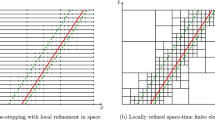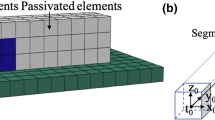Abstract
In the paper, a novel algorithm employing pseudo-spectral approach is developed for the PKN model of hydrofracturing. The respective solvers compute both the solution and its temporal derivative. In comparison with conventional solvers, they demonstrate significant cost effectiveness in terms of balance between the accuracy of computations and densities of the temporal and spatial meshes. Various fluid flow regimes are considered.












Similar content being viewed by others
References
Adachi J, Detournay E (2002) Self-similar solution of a plane–strain fracture driven by a power-law fluid. Int J Numer Anal Methods Geomech 26:579–604
Adachi J, Peirce A (2007) Asymptotic analysis of an elasticity equation for a finger-like hydraulic fracture. J Elast 90(1): 43–69
Adachi J, Siebrits E, Peirce A, Desroches J (2007) Computer simulation of hydraulic fractures. Int J Rock Mech Min Sci 44:739–757
Carter E (1957) Optimum fluid characteristics for fracture extension. In: Howard G, Fast C (eds) Drilling and production practices. American Petroleum Institute, pp 261–270
Crittendon BC (1959) The mechanics of design and interpertation of hydraulic fracture treatments. J Pet Tech 21:21–29
Detournay E (2004) Propagation regimes of fluid-driven fractures in impermeable rocks. Int J Geomech 4:1–11
Dobroskok AA, Linkov AM (2011) Modeling of fluid flow, stress state and seismicity induced in rock by instant pressure drop in a hydrofracture. J Min Sci 47(1):10–19
Economides M, Nolte K (eds) (2000) Reservoir stimulation, 3rd edn. Wiley, Chichester
Garagash DI, Detournay E (2000) The tip region of a fluid-driven fracture in an elastic medium. J Appl Mech 67:183–192
Geertsma J, de Klerk F (1969) A rapid method of predicting width and extent of hydraulically induced fractures. J Pet Tech 21:1571–1581 [SPE 2458]
Hubbert MK, Willis DG (1957) Mechanics of hydraulic fracturing. J Pet Tech 9(6):153–168
Kemp LF (1989) Study of Nordgren’s equation of hydraulic fracturing. SPE Prod Eng 5:311–314
Khristianovic SA, Zheltov YP (1955) Formation of vertical fractures by means of highly viscous liquid. In: Proceedings of the fourth world petroleum congress, Rome, pp 579–586
Kovalyshen Y, Detournay E (2009) A reexamination of the classical PKN model of hydraulic fracture. Transp Porous Media 81:317–339
Kovalyshen Y (2010) Fluid-driven fracture in poroelastic medium. PhD thesis, The University of Minnesota
Kusmierczyk P, Mishuris G, Wrobel M (2012) Remarks on numerical simulation of the PKN model of hydrofracturing in proper variables. Various leak-off regimes. arXiv:1211.6474
Lecampion B, Detournay E (2007) An implicit algorithm for the propagation of a hydraulic fracture with a fluid lag. Comput Method Appl Mech 196(49–52):4863–4880
Linkov AM (2011) Speed equation and its application for solving ill-posed problems of hydraulic fracturing. ISSM 1028-3358. Doklady Phys 56(8): 436–438
Linkov AM (2011) Use of a speed equation for numerical simulation of hydraulic fractures. arXiv:1108.6146
Linkov AM (2011) On efficient simulation of hydraulic fracturing in terms of particle velocity. Int J Eng Sci 52:77–88
Mishuris G, Wrobel M, Linkov A (2012) On modeling hydraulic fracture in proper variables: stiffness, accuracy, sensitivity. Int J Eng Sci 61:10–23
Mitchell SL, Kuske R, Peirce A (2007) An asymptotic framework for finite hydraulic fractures including leakoff. SIAM J Appl Math 67(2):364–386
Mitchell SL, Kuske R, Peirce AP (2007) An asymptotic framework for the analysis of hydraulic fractures: the impermeable case. ASME J Appl Mech 74(2):365–372
Moos D (2012) The importance of stress and fractures in hydrofracturing and stimulation performance: a geomechanics overview. Search and Discovery Article 80255
Nordgren RP (1972) Propagation of a vertical hydraulic fracture. J Pet Tech 253:306–314
Olson JE (2008) Multi-fracture propagation modeling: applications to hydraulic fracturing in shales and tight gas sands. In: The 42nd US rock mechanics symposium (USRMS), June 29–July 2, 2008, San Francisco, CA, USA
Peirce A, Detournay E (2008) An implicit level set method for modeling hydraulically driven fractures. Comput Methods Appl Mech Eng 197:2858–2885
Peirce A, Detournay E (2009) An Eulerian moving front algorithm with weak-form tip asymptotics for modeling hydraulically driven fractures. Numer Methods Eng 25(2):185–200
Perkins TK, Kern LR (1961) Widths of hydraulic fractures. J Pet Tech 13(9):37–49 [SPE 89]
Rubin AM (1995) Propagation of magma filled cracks. Annu Rev Earth Planet Sci 23:287–336
Sneddon IN, Elliot HA (1946) The opening of a Griffith crack under internal pressure. Quart Appl Math 4:262–267
Tsai VC, Rice JR (2010) A model for turbulent hydraulic fracture and application to crack propagation at glacier beds. J Geophys Res 115:1–18
Zhang X, Jeffrey R, Llanos EM (2004) A study of shear hydraulic fracture propagation. In: Gulf rocks, the 6th North America rock mechanics symposium (NARMS), June 5–9, 2004, Houston, TX, USA
Acknowledgments
The authors are grateful to the Institute of Mathematics and Physics of Aberystwyth University and EUROTECH Sp. z o. o. for the facilities and hospitality.
Author information
Authors and Affiliations
Corresponding author
Additional information
This work has been done in the framework of the EU FP7 PEOPLE project under contract number PIAP-GA-2009-251475-HYDROFRAC.
Appendix: Numerical benchmarks
Appendix: Numerical benchmarks
Let us define a set of benchmark solutions useful for testing different numerical solvers. Consider a class of positive functions \(C_+(0,1)\) described in the following manner:
By taking an arbitrary \(h\in C_+(0,1)\), one can build a benchmark solution for the normalized formulation of the problem as:
where functions \(\psi _j(t)\) and \(h(x)\) are specified below. On substitution of (63) into (26) one finds:
where two sets of the benchmark solutions can be considered. For the first one we choose \(\psi _1(t)=e^{\gamma t}\) and \(\beta =2/3\), \(\alpha =1\), while for the second, \(\psi _2(t)=(a+t)^\gamma \) and \(\beta =2\gamma /(3\gamma +1)\), \(\alpha =(3\gamma -1)/\gamma \). Corresponding crack lengths are defined in (25) and (30), respectively. Finally, the injection flux rate is computed from the boundary condition (16)\(_1\):
while the initial condition reads \(W(x)=u_0\psi _j(0)h(x)\).
Note that when taking the function \(h(x)\) from the class \(C_+(0,1)\) in the following representation:
\(q_l\) automatically satisfies the condition \(q_l(t,x)=O((1-x)^{1/3}),x\rightarrow 1.\)
The presented benchmarks allow one to test numerical schemes in various fracture propagation regimes (accelerating/decelerating cracks) by choosing proper values of the parameter \(\gamma \) [see Mishuris et al. (2012)]. Additionally, if one reduces the requirements for the smoothness of \(s(x)\) near \(x=1\), assuming that \(h\in C^2[0,1)\cap H^\alpha (0,1)\) the benchmark can serve to model singular leak-off regimes [compare with (61)].
Note that the zero leak-off case cannot be described by the aforementioned group of benchmarks. However, an analytical benchmark for this regime, represented in terms of a rapidly converging series, has been developed in Linkov (2011c).
Rights and permissions
About this article
Cite this article
Wrobel, M., Mishuris, G. Efficient pseudo-spectral solvers for the PKN model of hydrofracturing. Int J Fract 184, 151–170 (2013). https://doi.org/10.1007/s10704-013-9847-y
Received:
Accepted:
Published:
Issue Date:
DOI: https://doi.org/10.1007/s10704-013-9847-y




